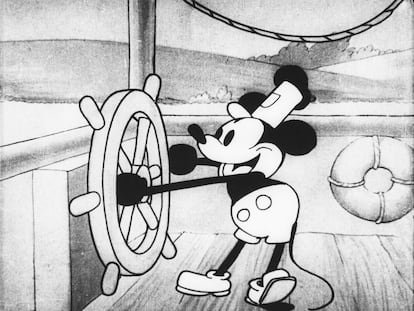Mickey Mouse smokes, drinks and kills: why Disney’s most famous rodent is no longer under its control
Several artists are taking advantage of the fact that Mickey has been in the public domain since January 1, 2024 in attacks on his company, which is renowned for the tight control it exercises on its trademarks

Mickey Mouse has changed dramatically since entering the public domain. That is to say, since he was no longer subject to copyright laws because, 75 to 100 years after its creation, intellectual property is no longer subject to use restrictions. Due to this, Mickey (or a Mickey, but will get to that shortly) can be used outside the iron fist of Disney, the multinational company that brought him to life. Now you can see him smoking, killing and committing acts of terrorism. The iconic mouse, the ultimate symbol of the American entertainment empire and one of those fabulous designs that can be recognized by its silhouette alone, is being reinterpreted by various artists dedicated to creating their own, extreme versions of the rodent. One on hand, they are reinterpreting a cultural legend. On the other, theirs is a kind of long-awaited revenge on the gigantic Disney corporation, and the iron fist with which it has protected use of its creations for decades.
Since January 1, 2024, artists’ collective enthusiasm has translated into an avalanche of content centered on the rodent. Of course, only his original version, that is to say, the black and white Mickey Mouse that was seen for the first time in the 1928 movie Steamboat Willie. If Mickey was once an icon of our childhood, of entertainment, of animated movies, the U.S. cultural empire has now become a symbol of the anticopyright movement.
Alex Cohen, a comic book illustrator who is popular on Instagram under his alias Tinisekcomics, was one of the first to subvert Mickey’s traditionally friendly image. Flush with irony, the author expressed the relief that he could “finally share this historic document with the American public without fear of legal consequences.” In his illustration, Mickey confesses to having assassinated former president John F. Kennedy, and says he’d do it again.
Some had already been planning their projects well before the character hit the public domain. In 2021, the MSCHF collective announced the creation of a “famous mouse”'s first work of art, and sold tokens that could only be redeemed in exchange for collectibles this year. The video game Inverse Ninjas VS. The Public Domain incorporated him practically as soon as it was possible, on January 1, 2024. The game’s characters belong in the public domain, like Alice (of Alice in Wonderland), Sherlock Holmes and Winnie the Pooh (who has also made the transition, once free of copyright laws, into a bloody killer). Other examples include Infestation: Origins, in which the rodent is possessed, and the webcomic Mousetrapped, in which he plans robberies. Various artists have portrayed him smoking, inciting class struggle, and in bed with Shrek.
The limits of humor
But in keep in mind that this freedom does not permit absolutely everything. Since only Mickey’s original black and white version is royalty-free, you are not allowed to use his most popular version, that of the white gloves, yellow shoes and red pants. And since it’s a trademarked brand, it is verboten to associate any new Mickey creation with Disney. Moreover, the release applies only within the U.S., for now. According to Javier R. Gigirey, a partner at the Gigirey Abogados law firm and former legal counsel to Disney in Spain, the famous mouse has not entered the public domain in Europe. “In the EU, the date of the death of the authors has to be taken into account in order to count from which date the copyright of the audiovisual work expires.” Thus, Mickey will be free of copyright in Europe 70 years after the death of his last author, that is, in 2036.
Duke University law professor Jennifer Jenkins, who is the director of Duke’s Center for the Study of the Public Domain, explained that “Disney drove through a law that expanded copyright duration to 95 years [from a previous duration of 75 years], which became known as the Mickey Mouse Protection Act.” She stresses that the text “has been criticized for having a devastating effect on our ability to digitize, archive and access our cultural heritage.”

Disney is known for rigorous, at times aggressive, protection of its brands. In 1989, the company threatened to sue three small childcare centers in Hallandale, Florida for having painted its characters on its walls, arguing that this could be associated with its companies. The lawsuit never came to fruition thanks to the intervention of Universal Studios, which allowed the depiction of its characters as part of an advertising campaign. In 2008, Disney sued a couple receiving government aid for wearing costumes similar to those of Tigger and Eeyore from the Winnie the Pooh. Currently, the U.S. giant is taking a Chilean car wash service called Star Wash to court over its improper use of the Star Wars trademark.
Is Disney worried? An article published by The Guardian quotes Robert Thompson, Syracuse University professor of film, radio and television. “I always say any of us going past 100 years will usually have issues, but this whole original Mickey Mouse thing is something to think about as we look at Disney going into its second century with a good deal of troubles. Disney has a lot of things to worry about right now, and the expiration of Steamboat Willie’s Mickey Mouse probably shouldn’t be on the top of their list. The original Mickey isn’t the one we all think of and have on our T-shirts or pillowcases up in the attic someplace. Yet, symbolically of course, copyright is important to Disney and it has been very careful about their copyrights to the extent that laws have changed to protect them. This is the only place I know that some obscure high school in the middle of nowhere can put on The Lion King and the Disney copyright people show up.”
According to Jenkins, the situation is even more unjust if we take into account the “success” that Disney has had in “the exploitation of the public domain” throughout its history. The professor mentions that The Snow Queen by Hans Christian Andersen (whose original works are now in the public domain) served as inspiration for Frozen, while Hamlet influenced The Lion King. In addition, the company has also produced innumerable versions of classic stories like Alice in Wonderland, Snow White and The Hunchback of Notre Dame. It would seem that public domain only pleases the company when it works in its interests.
Even so, Jenkins maintains that Mickey will stand the test of time, with or without copyright. “His universe is much broader than what is fashionable on social media at any given time,” she says. She thinks the extreme versions of the character (smoker, homosexual, terrorist) capture attention because of the contrast they present with the candor and innocence with which we associate him. We’ll have to wait to see the true cultural relevance of these experiments. “If we think of other characters in the public domain, like Pinocchio [of whom a film was released as early as 1996 in which is a blood-thirsty murderer] or Robin Hood [of whom there are even pornographic productions], what versions come to mind? The Disney movies,” she concludes. The expert explains that these parodies can have the opposite effect: “There are studies that show that unpleasant uses of an iconic character reinforce the prestige of the original. Time will tell, but there is reason to believe that Disney’s Mickey will remain intact in the public imagination,” she says.
One of the first, notorious cases of Disney bringing a lawsuit against artists involved the Air Pirates collective, which published comics by the same name that showed Mickey trafficking drugs and participating in sexual encounters. The company withdrew the lawsuit after the authors agreed to stop publication. Disney managed to safeguard its founding symbol for almost a century, and all indicators point to its enormous power managing to keep its image intact and shielded in the collective imagination. However, right now, somewhere, while you read these very lines, someone is drawing Mickey Mouse doing horrible things. And it’s legal.
Sign up for our weekly newsletter to get more English-language news coverage from EL PAÍS USA Edition
Tu suscripción se está usando en otro dispositivo
¿Quieres añadir otro usuario a tu suscripción?
Si continúas leyendo en este dispositivo, no se podrá leer en el otro.
FlechaTu suscripción se está usando en otro dispositivo y solo puedes acceder a EL PAÍS desde un dispositivo a la vez.
Si quieres compartir tu cuenta, cambia tu suscripción a la modalidad Premium, así podrás añadir otro usuario. Cada uno accederá con su propia cuenta de email, lo que os permitirá personalizar vuestra experiencia en EL PAÍS.
¿Tienes una suscripción de empresa? Accede aquí para contratar más cuentas.
En el caso de no saber quién está usando tu cuenta, te recomendamos cambiar tu contraseña aquí.
Si decides continuar compartiendo tu cuenta, este mensaje se mostrará en tu dispositivo y en el de la otra persona que está usando tu cuenta de forma indefinida, afectando a tu experiencia de lectura. Puedes consultar aquí los términos y condiciones de la suscripción digital.
More information
Archived In
Últimas noticias
Most viewed
- Reinhard Genzel, Nobel laureate in physics: ‘One-minute videos will never give you the truth’
- Oona Chaplin: ‘I told James Cameron that I was living in a treehouse and starting a permaculture project with a friend’
- Pablo Escobar’s hippos: A serious environmental problem, 40 years on
- Why we lost the habit of sleeping in two segments and how that changed our sense of time
- Chevy Chase, the beloved comedian who was a monster off camera: ‘Not everyone hated him, just the people who’ve worked with him’











































